The Underground Railroad’s best known conductor was also a suffragist, a warrior, and a caretaker. From her own self-emancipation on the eastern shore of Maryland to her heroic service during the Civil War, her advocacy for the rights of women and African Americans, and her work to care for the poor and homeless in her community…Harriet Tubman’s unswerving determination changed the lives of countless Americans, making her a towering figure in our nation’s history.
Explore the places of Harriet Tubman

Harriet Tubman Underground Railroad National Historical Park: here is where she liberated herself, her family, and others who were enslaved.

At Harriet Tubman National Historical Park in New York, see her home and the places where she cared for others.

Over 600 sites in the Underground Railroad Network to Freedom share stories of self-emancipation and the courageous journey to freedom.
- Type: Place
- Locations: Captain John Smith Chesapeake National Historic Trail, Chesapeake Bay

Discover the Seaford Museum, a hidden gem in downtown Seaford, Delaware. Just steps from the Nanticoke River, this award-winning museum showcases the region’s rich history, from Harriet Tubman’s Underground Railroad connections to its maritime legacy. Explore interactive exhibits on shipbuilding and oyster shucking. After your visit, enjoy a scenic stroll along the River Walk, where Seaford’s waterfront industry stories come to life!
- Reconstruction Era National Historical Park
William C. Morrison
- Type: Person
- Locations: Reconstruction Era National Historical Park

The story of an enslaved man in Charleston liberating himself aboard a stolen Confederate vessel, who came to Beaufort, purchased property, served in the military, owned a business, and was elected to political office – sounds like a familiar story to many in the South Carolina Lowcountry. However, most people have never heard of William C. Morrison.
- Type: Person
- Locations: Charles Young Buffalo Soldiers National Monument, Fort Davis National Historic Site, Fort Sumter and Fort Moultrie National Historical Park, Guadalupe Mountains National Park, Reconstruction Era National Historical Park
- Interpretation and Education
Telling All Americans' Stories: Introduction to Women's History
- Type: Article
- Offices: Interpretation and Education

From the lives of young, immigrant women who worked the textile mills at Lowell National Historic Park to those of the female shipyard workers who were essential to the home front during World War II at Rosie the Riveter/World War II Home Front National Historic Park, women’s history can be found at every park. If you want to understand our nation’s history, explore the remarkable legacies of American women.
- Type: Article
- Locations: Harriet Tubman National Historical Park, Reconstruction Era National Historical Park
- Harriet Tubman National Historical Park
Thompson Memorial African Methodist Episcopal Zion Church
- Type: Place
- Locations: Harriet Tubman National Historical Park
- Offices: Network to Freedom

Built in 1891, the Thompson Memorial African Methodist Episcopal Zion church represented a place of worship and a cornerstone of Auburn’s Black community. Harriet Tubman, a prominent member of this community, worshipped at this church alongside her family. The church became Tubman’s final resting place when she passed away in 1913. Registered as a National Historic Landmark in 1974, the church building was purchased by the National Park Service in 2017.
- Type: Person
- Locations: First State National Historical Park, Fort Sumter and Fort Moultrie National Historical Park, Harriet Tubman National Historical Park, Harriet Tubman Underground Railroad National Historical Park, Reconstruction Era National Historical Park
- Offices: Network to Freedom
- Reconstruction Era National Historical Park
Beaufort's "Contraband" Hospital
- Harriet Tubman National Historical Park
Harriet Tubman Home
- Type: Place
- Locations: Harriet Tubman National Historical Park

Harriet Tubman bought a 7-acre area of land in of 1859 in Auburn, New York. There was a barn and a farmhouse, where Harriet Tubman would move her family from St. Catharines, Canada, south to Auburn, New York. In 1880, a fire destroyed the original wood-frame house after a resident under Harriet’s care used a defective stovepipe as a chimney in their room. Harriet Tubman and her family constructed a new brick house in 1882 and lived in that building until her passing in 1913.
- Harriet Tubman National Historical Park
Harriet Tubman Home for Aged & Indigent Negroes
- Type: Place
- Locations: Harriet Tubman National Historical Park

At the age of 74, Tubman purchased at auction a 25 acre parcel of land with numerous structures which abutted her residential property. Her hope was to establish the Tubman Home for Aged and Indigent Negroes to carry on her work, after she was gone, of caring for the old and poor in her community. When she was unable to raise funds necessary to open the facility, Tubman deeded the property to the African Methodist Episcopal Zion Church
Last updated: October 24, 2019




